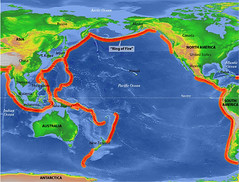Wednesday, April 29, 2009
Ring of Fire - Plate Tectonics
Plate tectonics, reading comprehension & The Ring of Fire
Reading in the World Geography text or sources such as Wikipedia
1. Geologists believe the history of the earth spans some ___ years.
2. Nickel and iron soup: components of the earth’s __.
3. A thick pudding of iron and nickel: the __ __.
4. If you drape a beautifully decorated cloth over the shoulders of a priest, it is called a mantle. Explain how the earth’s geologic term, “mantle,” parallels this meaning. (one sentence)
5. The earth’s crust is made of flour, water, salt and rock. T / F
6. The crust varies in flavor. The seaweed crust is some __ miles thick. The baked crust is often about __ miles thick.
7. Why do you and I not agree with the text in regards the surface of the planet? We believe the earth is covered with trees, not seawater. Why do we believe this (go with me on this one, ok?) to be true? (one sentence)
8. Meantime, according to your text, what percentage of earth is not covered with water?
9. The largest continental mass?
10. How do you spell the “difference in elevation” on the land’s surface?
11. It’s called magma sometimes and lava at other times. What is it and why the dif?
12. Would you rather live near a fault or a fold in the earth’s crust?
Explain a fold.
13. The earth’s crust and the upper layer of mantle makes up the ___. “Lith” refers to rock and “sphere” refers to the ______.
14. Do the earth’s plates move Toward each other or Apart from each other?
15. Write down the etymology of the term Pangaea.
16. Would you call the 180 million years since continental drift began an extremely ancient earth phenomenon or relatively recent one? Explain by giving one additional measurement.
17. Explain the use of fossil evidence in the continental drift theory.
(one sentence)
18. A split in the earth’s crust is called a __.
19. Scientists believe in the theory of seafloor spreading. T / F
20. How do the earth’s crustal plates get the power to move?
21. If thermal energy is involved, what’s the source of the tectonic heat?
22. Sketch the platal dance that occurs when continental crust meets the oceanic crust.
23. In the case of the Andes Mtns., what’s ironic about subduction?
24. When continental plates collide, what is the result?
25. Which plates created the Himalayas?
Locations that are part of the Pacific Ring of Fire region, Y (yes) or N (no):
26. Philippines
27. Hawaii
28. Mexico
29. Chile
30. Bering Strait
31. Mt Vesuvius
32. Tasmania
33. Alaska
34. Indonesia
35. China
36. Ecuador
37. The Nazca Plate and the South American plate: a) subduction b) spreading
38. The San Andreas zone: a) converging b) faulting.
39. “Hot spots” in the mantle are associated with a) archipelagos
b) geysers c) mitosis.
Answers:
1. Earth span: 4.6 billion years. Did you wonder how this estimate was generated?
2. Nickel & iron soup: outer core. What’s the composition of nickel?
Why nickel & iron?
3. Nickel & iron pudding: inner core.
4. The mantle is a robe draped over the core.
5. True. Why not?
6. seaweed: 5 miles “down.” baked crust: 20 miles deep. Surprised?
7. Local observation: when we observe local terrain it is tree rich. No seawater round here, yet.
8. About 30% not watery.
9. Eurasia is largest. It’s bigger than Texas.
10. r-e-l-i-e-f.
11. Magma, lava: molten rock inside or outside the crust.
12. Neither. A fold is when a stratum of rock is bent or curved by huge force. The Appalachians are folds. There are upfolds (assoc w petroleum & coal deposits), or domes, and downfolds, or depressions.
13. lithosphere: crust & mantle. globe.
14. Both.
15. pan, “across” or “all,” and gaia, “earth.”
16. Recent compared to 4.6 billion years of history.
17. Fossils are the same in separated plates, proving a historic closeness (an example: tapir fossils found in the ice of Antarctica as well as Chile & Argentina at the southern tip of South America).
18. split: rift.
19. True, re seafloor spreading. Proven by photos taken by remote-controlled submarines.
20. Thermal energy or convection.
21. Thermal: decaying organic matter.
22. Subduction: coastal crust folds under the continental.
23. Subduction assoc with the opposite: mountain formation.
24. Plates collide: converging or faulting. Violence.
25. Indo-Australian plate vs. the Eurasian plate: Himalayas.
26. Philippines: Y
27. Hawaii: Y
28. Mexico: Y
29. Chile: Y
30. Bering Strait: Y
31. Vesuvius: N
32. Tasmania: N
33. Alaska: Y
34. Indonesia: Y
35. China: Y
36. Ecuador: Y
37. Nazca plate & S. Am. plate: subduction
38. San Andreas: faulting
39. Hot spots: a) archipelagos b) geysers and c) mitosis.
40. Most critical hydrologic issue of the ArkLaTex? hydrology, or water supply
Possibility . . .
Skits on the Ring of Fire (3 mins max presentation)
Objective: explain the overall nature of the Pacific Ring of Volcanoes and tectonic plates. Be explanatory and imaginative.
Use map on board in the script.
Skit-writing groups based on each row.
Script material to be recited will be written on index cards. Each person must speak at least twice.
Please integrate 5 key words & explanations (ex: crust, rinf of fire, etc) from the vocabulary list. Make sure they are defined, even if informally.
One person may make a graphic - a poster - to announce the skit.
8 pts- 4 for script quality; 4 for performance.
Subscribe to:
Post Comments (Atom)


No comments:
Post a Comment